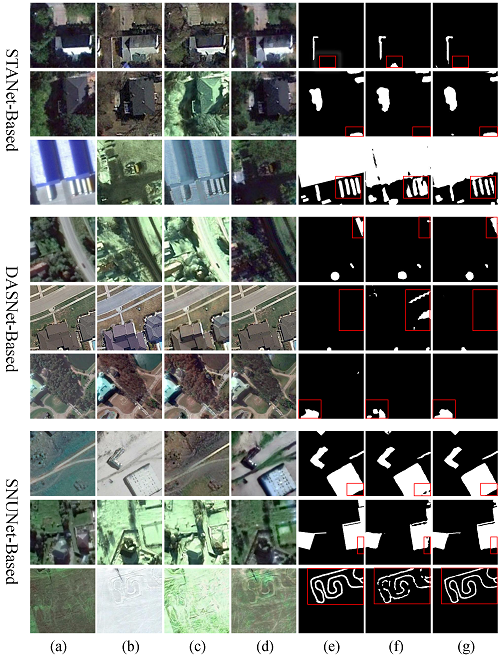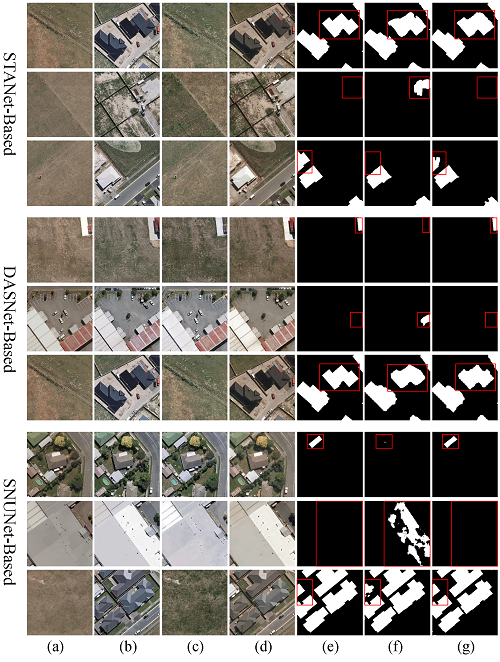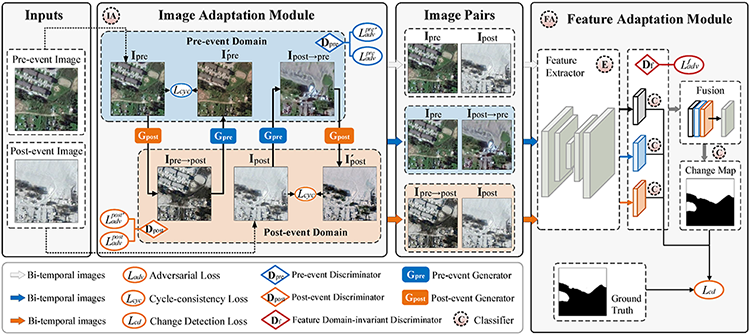This software implements SDACD: An End-to-end Supervised Domain Adaptation Framework for Cross-domain Change Detection in PyTorch. For more details, please refer to our paper https://arxiv.org/abs/2204.00154
Change Detection is a crucial but extremely challenging task of remote sensing image analysis, and much progress has been made with the rapid development of deep learning. However, most existing deep learning-based change detection methods try to elaborately design complicated neural networks with powerful feature representations, but ignore the universal domain shift induced by time-varying land cover changes, including luminance fluctuations and season changes between pre-event and post-event images, thereby producing sub-optimal results. In this paper, we propose an end-to-end Supervised Domain Adaptation framework for cross-domain Change Detection, namely SDACD, to effectively alleviate the domain shift between bi-temporal images for better change predictions. Specifically, our SDACD presents collaborative adaptations from both image and feature perspectives with supervised learning. Image adaptation exploits generative adversarial learning with cycle-consistency constraints to perform cross-domain style transformation, effectively narrowing the domain gap in a two-side generation fashion. As to feature adaptation, we extract domain-invariant features to align different feature distributions in the feature space, which could further reduce the domain gap of cross-domain images. To further improve the performance, we combine three types of bi-temporal images for the final change prediction, including the initial input bi-temporal images and two generated bi-temporal images from the pre-event and post-event domains. Extensive experiments and analyses on two benchmarks demonstrate the effectiveness and universality of our proposed framework. Notably, our framework pushes several representative baseline models up to new State-Of-The-Art records, achieving 97.34% and 92.36% on the CDD and WHU building datasets, respectively.
Install PyTorch 1.7.1+ and other dependencies:
pip/conda install pytorch>=1.7.1, tqdm, tensorboardX, opencv-python, pillow, numpy, sklearn
Download the datasets from Baidu Netdisk(Extraction code:rvbv).
Generate the train.txt, val.txt and test.txt
python write_path.py
A demo program can be found in demo. Before running the demo, download our pretrained models from Baidu Netdisk (Extraction code: eu68) or Google drive. Set the path of files in tmp/***.pt. Then launch demo by:
python eval.py
python eval.py
python visualization.py
Generate the train.txt, val.txt and test.txt:
python write_path.py
Submit the train.sh:
sbatch train.sh
Here gives some examples of change detection results, comparing with existing methods on CDD Dataset in Figure (a), and Figure(b) is the results on WHU Dataset.
| (a) | (b) |
|---|---|
 |
 |
Evaluation of SDACD on different datasets with SNUNet, STANet, and DASNet as baseline:
| Methods | CDD | WHU building | ||||
|---|---|---|---|---|---|---|
| P(%) | R(%) | F(%) | P(%) | R(%) | F(%) | |
| FC-EF | 84.68 | 65.13 | 73.63 | 80.75 | 67.29 | 73.40 |
| FC-Siam-diff | 87.57 | 66.69 | 75.07 | 48.84 | 88.96 | 63.06 |
| FC-Siam-conc | 88.81 | 62.20 | 73.16 | 54.20 | 81.34 | 65.05 |
| STANet | 83.17 | 92.76 | 87.70 | 82.12 | 89.19 | 83.40 |
| SDACD-STANet | 87.40 ↑****4.23 | 89.50 ↓****3.26 | 88.40 ↑****0.70 | 90.90 ↑****8.78 | 93.50 ↑****4.31 | 92.21 ↑****8.81 |
| DASNet | 93.28 | 89.91 | 91.57 | 83.77 | 91.02 | 87.24 |
| SDACD-DASNet | 92.85 ↓****0.43 | 91.87 ↑****1.96 | 92.35 ↑****0.78 | 89.21 ↑****5.44 | 90.46 ↓****0.56 | 89.83 ↑****2.59 |
| SNUNet | 96.60 | 94.77 | 95.68 | 82.12 | 89.19 | 85.51 |
| SDACD-SNUNet | 97.13 ↑****0.53 | 97.56 ↑****2.79 | 97.34 ↑****1.66 | 93.85 ↑****11.73 | 90.91 ↑****1.72 | 92.36 ↑****6.85 |
The grid search results of λf and λCD. Here we fixed λcyc=10 and λi=1.
| Baseline | λf | λCD | P(%) | R(%) | F(%) |
|---|---|---|---|---|---|
| 1 | 0.05 | 93.38 | 90.85 | 92.10 | |
| 1 | 0.1 | 93.85 | 90.91 | 92.36 | |
| SNUNet | 1 | 0.2 | 93.92 | 90.94 | 92.09 |
| 0.5 | 0.1 | 93.31 | 91.28 | 92.28 | |
| 1 | 0.1 | 93.85 | 90.91 | 92.36 | |
| 2 | 0.1 | 94.56 | 89.99 | 92.22 |
The authors would like to thank the developers of PyTorch, SNUNet, STANet, and DASNet. Please let me know if you encounter any issues.
